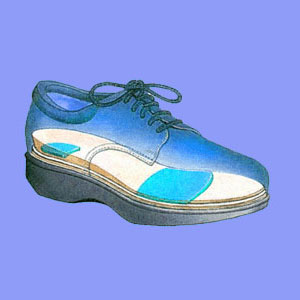
Sciatica shoe inserts are primarily marketed to patients who want to find relief when standing or walking for long periods of time. There are several major companies currently claiming that their shoe inserts might provide benefits for sciatica pain and the profits from their capitalist ventures are huge. However, are the products actually helpful or are they yet another in a long line of scams?
Shoe inserts come in several styles and many price points. Sciatica treatment shoe inserts are no exception, with bargain basement styles costing under $10, while high-end custom orthotics might cost upwards of $1000. Materials range from memory foam to silicone to other choices. There seems to be hundreds of different styles, which tells that there is no single design most commonly thought to be best for relieving sciatica. This fact is the first clue that spending a large sum of money on shoe inserts is probably not the best investment for most patients.
This consumer guide helps to educate patients on the truths of sciatica shoe inserts. We provide this essay not only to help patients to find the pain relief that they need, but also to protect them against the common financial scams that are so commonplace in the medical device sector.
Types of Sciatica Shoe Inserts
Sciatica inserts are all placed in existing shoes and are designed to help reduce pain when the patient is on their feet. Obviously, the positive effects will be lessened or negated completely if the patient is not standing or walking. There are still many styles of inserts that are available including all of the following products:
Cheap inserts are generally priced under $20. These products rarely make medical claims, but instead generalize about their benefits for overall comfort. Most of these products are made from cheap foam, memory foam or low grade silicone. These are sold in drug stores, online and from various retailers. These products are disposable and are generally not meant to last for too long.
Higher-end consumer sciatica shoe inserts are also sold in drug stores, shoe stores, online and in specialty retailers. These products are usually made from special foams, medical grade silicone, latex, leather or other material. Most of these products are meant to last and should serve the user for over a year and possibly much longer. Pricing varies greatly, with our experience showing a cost range of $25 to $199 dollars being typical. Some products feature reflexology or massage beads integrated into the design, while others might include magnets or other accessory benefit.
High-end custom inserts are generally available from chiropractors, some physicians, and orthotic makers. These are made for each patient using a variety of techniques and materials, depending on the patient’s needs. Custom orthotic insoles range from $200 to over $1000 per pair and should last a very long time.
Marketing of Orthotic Shoe Inserts
Low-end shoe inserts generally make few claims or are manufactured and sold in geographic areas where companies can claim virtually anything with little governmental regulation. In our travels, we have seen many products, including shoe inserts, claiming to provide miraculous cures for just about every ailment know to man. It should not take a genius to see past this desperate type of unregulated marketing.
Mid and high-end insoles often make more lofty claims as their price goes up. This is because these devices are insanely profitable and the companies that make them can invest heavily in particular methods of research that basically bypass proper scientific methods and practices. Most of these products are marketed as health and beauty aids and not medical devices, so the burden of proving claims is greatly diminished.
As with so many sciatica products, we find that people who are in pain will try virtually anything to achieve some measure of relief and the companies who manufacture these products count on this exact fact. Just remember that the “research” cited by most companies is self-produced and financially-motivated, meaning that a conclusion for efficacy exists before the study even begins and the company’s only hurdle is finding some data to back it up; regardless of how insignificant that relief is or how coincidental the product may be to achieving the relief.
Efficacy of Sciatica Shoe Inserts
There is no doubt that shoe inserts can increase comfort while standing and possibly provide additional benefits. Quality shock-absorbing inserts can minimize fatigue and pressure points in the feet, helping to prolong the duration comfortable standing. Shoe inserts might also help extend the life of shoes, helping to differ some of their cost.
Inserts with added features, such as massage or magnet therapy options, might provide some benefit for patients who believe in these practices. However, the benefit gained is almost surely to be based on placebo effect and programmed response rather than any true efficacy. There is little, if any, scientific evidence demonstrating any actual benefit to these features.
Shoe inserts that are provided with the express intent of leveling out short leg syndrome can be effective at reducing pain, if the symptoms are actually due to the leg length discrepancy. Remember that most cases of SLS are not symptomatic and do not need correction, except for purely aesthetic reasons that might be important to the patient. For patients who are seeking short leg correction, we strongly advise purchasing quality orthotics from a custom manufacturer for best results.
There is virtually no proof that any other type of insert will have any benefit for sciatica pain specifically. True sciatica is generated from nerve pathologies in the lower spine and will not respond to any changes made to the feet. Pseudo-sciatica can come from many possible causes, but there is still little hope that shoe inserts will do anything to resolve the most common causes, including piriformis muscle compression of the sciatic nerve, sacroiliac pain or other local source of symptomatic activity in the legs or feet.
Sciatica shoe inserts might provide some efficacy due to the magnificent placebo effect, particularly if they are pricey and new. However, we know that placebo efficacy is usually extremely transient and should not be relied upon.
Shoe Insert Guidance for Pain
We advise most patients to save their money when it comes to treating sciatica with shoe inserts. If you have a highly specific complaint, such as verified pseudo-sciatica pain due to short leg syndrome, then this is a completely different matter altogether. However, most patients will not find any relief from these products, regardless of how much money is invested.
That being said, we do recommend that inserts can certainly increase general comfort in many standing postures and activities. If you have actual localized foot pain, then inserts might be one of the best solutions for your problem. Some of the best deals come from the lower end of the mid-range product market. Inserts costing $20 to $50 can provide results that rival custom-made orthotics for some people. We advise investigating this price segment before considering investing anything more in a product that might do little in terms of actually reducing pain.





